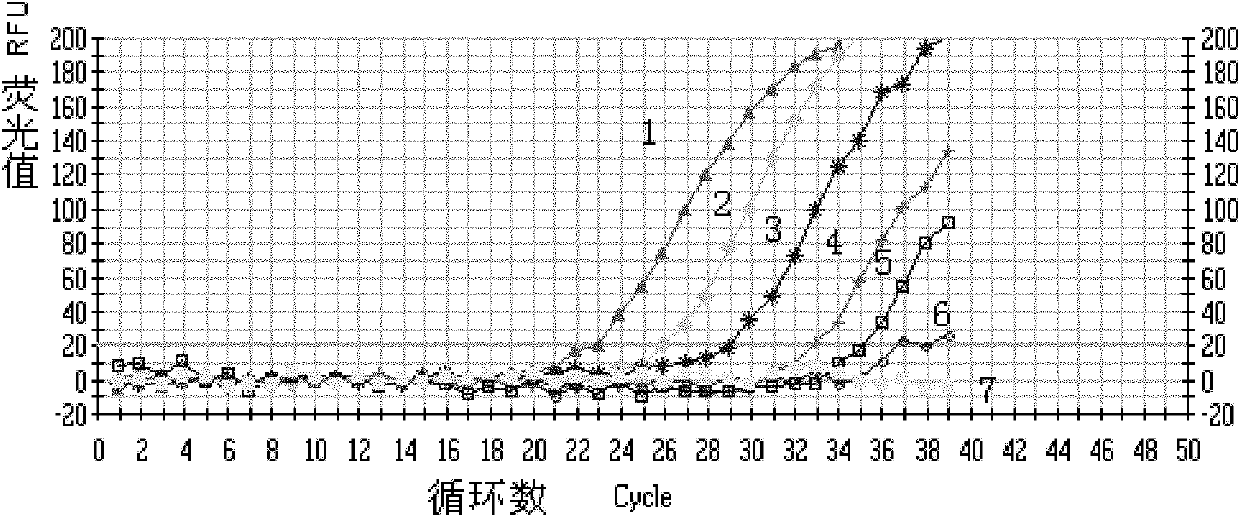Reagent for detecting francisella tularensis and complex probe and fluorescent quantitative polymerase chain reaction (PCR) method for detecting francisella tularensis
A fluorescence quantification, Tula technology, applied in the direction of biochemical equipment and methods, microbial determination/inspection, etc., can solve the problems of easy cross-contamination, difficult separation and cultivation, strong pathogenicity of Tula bacteria, etc. The effect of ensuring specificity and shortening detection time
- Summary
- Abstract
- Description
- Claims
- Application Information
AI Technical Summary
Problems solved by technology
Method used
Image
Examples
Embodiment 1
[0018] Example 1 Preparation of primers and probes
[0019] 1 Target gene selection
[0020] The FopA gene encodes the outer membrane protein of Francisella tularensis, and there are still anti-fopA antibodies in the serum of people in the recovery period. This gene is highly conserved in the Francisella genus and can be used as a nucleic acid diagnostic marker for Francisella tularensis. The gene sequence was obtained by searching the genbank database.
[0021] 2PCR primer design and screening
[0022] Following the principles of compound probe design, two sets of primers and probes were designed according to the FopA gene sequence.
[0023] The 5' end of the fluorescent probe is labeled with fluorescent molecule FAM as a reporter group, and the 3' end is labeled with phosphate to block its extension. A quenching group Dabcyl is connected to the 3' end of the quenching probe.
[0024] In order to screen a combination with high amplification efficiency from two sets of com...
Embodiment 2
[0036] Embodiment 2, the detection of Francisella tularensis
[0037]In order to investigate the practical application ability of the detection of the present invention, a simulated blood sample contaminated by Francisella tularensis was specially prepared, and pure bacteria were set as a positive control, and non-Francis tularensis pathogenic bacteria were used as a negative control.
[0038] 1. Sample Preparation
[0039] (1).Preparation and treatment of contaminated blood: fixed-value Francisella tularensis was serially diluted with anticoagulant blood to make a concentration of 1×10 6 CFU / ml-1×10 1 CFU / ml of contaminated blood samples. Take 1ml of blood containing different concentrations of bacteria, centrifuge at 12000rpm for 10 minutes, discard the supernatant, add 1ml of red blood cell lysate (50mmol / LTrisHCL, 25mmol / L KCl, 5mmol / LMgCl 2 , pH7.5, TKM solution), shake vigorously for 2 minutes, centrifuge at 12000rpm for 10 minutes, discard the supernatant, add 1ml of...
PUM
 Login to View More
Login to View More Abstract
Description
Claims
Application Information
 Login to View More
Login to View More - R&D Engineer
- R&D Manager
- IP Professional
- Industry Leading Data Capabilities
- Powerful AI technology
- Patent DNA Extraction
Browse by: Latest US Patents, China's latest patents, Technical Efficacy Thesaurus, Application Domain, Technology Topic, Popular Technical Reports.
© 2024 PatSnap. All rights reserved.Legal|Privacy policy|Modern Slavery Act Transparency Statement|Sitemap|About US| Contact US: help@patsnap.com










